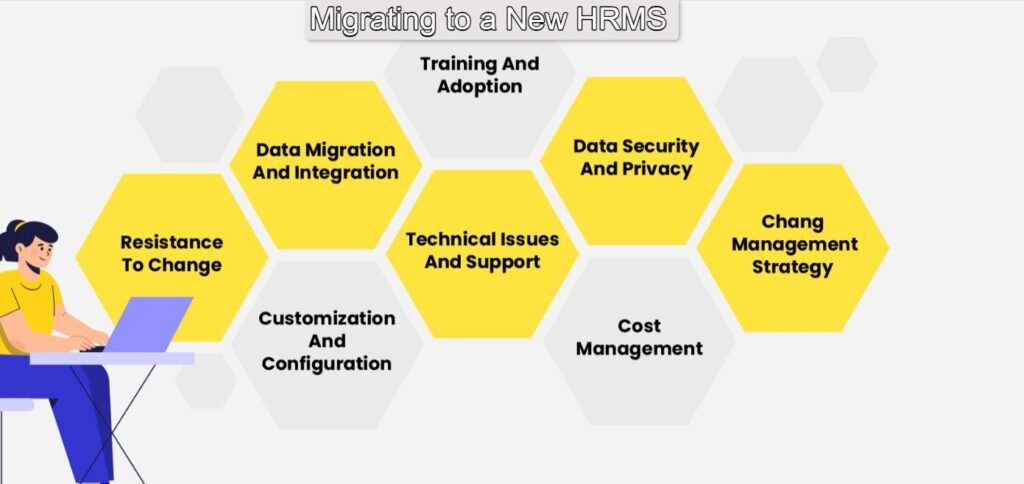
Migrating to a New HRMS
Making the switch to a modern Human Resource Management System (HRMS) is a important decision for any business. If you’re moving from an old system, switching from spreadsheets and upgrading your system to a more robust system The goal is the same: to increase efficiency, streamline HR processes, enhance the compliance of employees, and offer the best employee experience.
But it is true that an HRMS change is not only an IT switch, it’s a transformation for business that impacts every single part that your employees work. If the migration is not planned properly, it could cause the loss of data, operations disruption users’ frustration and miss business opportunities. However the right migration plan will guarantee a smooth transition, maximum acceptance by users, and an increased return on investment.
This article will provide a thorough overview of the essential things to think about when converting to an entirely new HRMS.
Top 10 Things to Consider before Migrating to a New HRMS
1. Define Clear Business Objectives
Understanding the reasons why behind the decision to migrate is crucial. Are you considering scaling operations? Enhance compliance? Improve the user experience? Replace technology that is outdated?
What to Do:
Set goals that are measurable and KPIs like:
- Reduced processing time for payroll by 50 per cent
- Improved efficiency onboarding
- Enhancing reporting capabilities
- Remote access is possible and mobile HR services.
Clare objectives can help you choose the right platform, and you can set expectations for the entire organization.
2. Evaluate Your Current System and Processes
Before deciding to switch to a different system, you need to know what functions and what doesn’t in the current HR configuration.
What to do:Conduct a detailed audit:
- What modules are currently in use?
- What manual procedures are still in place?
- What are the major issues for managers, HR and employees?
Workflows for documents, approval chains and the requirements for compliance. This is the basis for the customization of the HRMS that is being developed.
3. Choose the Right HRMS Platform
Selecting an HRMS that doesn’t meet your needs as an organization could lead to waste of resources and a low level of adoption.
What to do:Evaluate vendors based on:
- Scalability (will it allow for future growth?)
- Features (payroll, onboarding, performance, compliance, etc.)
- Integration capabilities (with ERP, accounting CRM, ERP)
- Cloud vs. on-premise alternatives
- Mobile readiness and user interface
- Local conformity (PF, ESI, TDS, DPDP Act)
Don’t be merely focused on price prioritizing long-term value.
4. Plan a Robust Data Migration Strategy
Data is the core of HR functions. Loss or errors during migration could cripple HR functions and undermine trust.
What to Do:
- Cleanse and verify information on employees that is current.
- Eliminate duplicates and obsolete records
- Formats that are standardized (e.g. dates of birth, date, or other bank information)
- Create data maps of fields that are new and old
- Utilize the phased or pilot migration method to check the accuracy of your method.
- Always back up your legacy data
Be sure that information you are keeping confidential is encrypted and securely transferred.
5. Integrate seamlessly With Existing Systems
HRMS seldom functions in isolation. It must be integrated with biometric devices, payroll software and finance tools, as well as training systems, and many more.
What to Do:
Verify API compatibility and support from the vendor for integrations with:
- Payroll and accounting systems (Tally or QuickBooks.)
- Attendance/Biometric devices
- Learning Management Systems (LMS)
- Platforms for CRM or ERP
Integrated systems eliminate redundant data, assure consistency of data and increase reports.
6. Participate Stakeholders From the Beginning
HRMS has a direct impact on multiple departmentsIt affects several departments: HR IT, Finance and employees. The lack of support for HRMS leads to resistance and poor implementation.
What to Do:
Establish a cross-functional implementation group that includes members from:
- HR (process experts)
- Information Technology (tech connection and assistance)
- Finance (for payroll and compliance)
- Line managers and employees’ representative (end users)
Get them involved early to get feedback as well as testing and process validation.
7. Customize Workflows Thoughtfully
Customization that is too extensive can cost more delays in implementation, and cause future upgrades to be more difficult.
What to Do:
Use native features of the platform in the greatest extent feasible. Only modify if it is necessary:
- Access controls based on role
- Approval hierarchies
- Department-specific flow of onboarding
- Localization to ensure compliance and language
Pick a system that is customizable that is not just customizable.
8. Plan Comprehensive Training and Change Management
Even the most robust HRMS will fail if users don’t know how to utilize it.
What to Do:
Plan a course of training for various user groups:
- HR managers
- Line managers
- Employers (self-service users)
Provide documentation, videos tutorials, webinars and Live Q&A meetings. Explain the advantages from the brand new HRMS clearly, focus on the ways it can make the work of everyone easier.
9. Test Thoroughly Before Going Live
Testing makes sure that data accuracy, workflows and integrations work in the way that is expected prior to full deployment.
What to Do:
- Conduct User Acceptance Testing (UAT)
- Run test payrolls
- Simulate the flow of onboarding
- Verify the reports and analysis.
- Verify integration points
Gather feedback, address bugs, and then run another test run prior to the final launch.
10. Set Up Post-Go-Live Support and Maintenance
Post-launch problems are not uncommon. The absence of support on a regular basis can cause prolonged interruptions.
What to Do:
Ensure your vendor provides:
- A dedicated customer success specialist or account manager
- Support based on SLA (email chat, email, phone)
- Regular system updates
- Documentation and refresher training
Establish internal super-users, or champions to provide first-level support within the company.
Conclusion
Moving to a new HRMS isn’t simply a matter of upgrading technology -it’s a transformation of the business that requires meticulous planning, collaboration and implementation. When you consider the factors mentioned above, companies can be sure of a smooth transition, which will bring an ongoing benefit.
If you take the proper approach, an HRMS can not just automate the routine tasks, but also help your business with data-driven insight in compliance readiness, as well as an improved employee experience. In today’s ever-changing workplace A well-functioning HRMS is an essential pillar of development, agility, and operational efficiency.





More Stories
Is Sansui an Indian Company? True Or Not
Handles Salary Revision and Appraisal: 10 Fact
Is Walmart an Indian Company? True Or Not